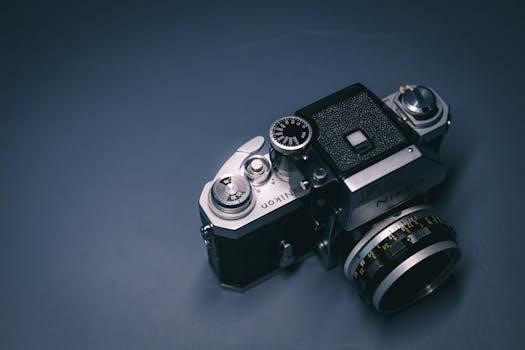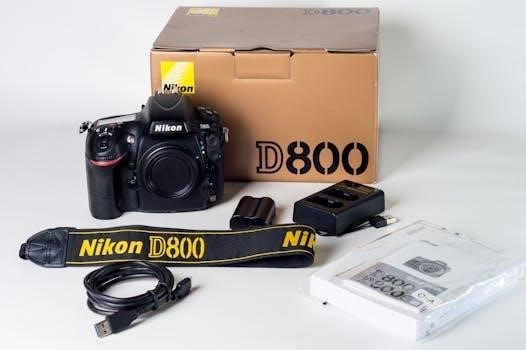
Welcome to your comprehensive resource for the Nikon D750․ This guide provides access to the official user manual‚ offering detailed instructions and specifications․ Whether you seek a PDF download or online viewing‚ you’ll find the information needed to master your camera․ Explore essential features and settings with our in-depth manual․

The Nikon D750 is a versatile full-frame DSLR camera renowned for its exceptional image quality and robust performance․ This camera is designed to cater to both enthusiast and professional photographers‚ offering a compelling blend of high-resolution imaging‚ advanced features‚ and user-friendly operation․ The D750 boasts a 24․3-megapixel sensor‚ allowing for capturing detailed and vibrant photographs across various lighting conditions․ Its reliable autofocus system ensures sharp focus in dynamic environments‚ while the camera’s build provides durability and comfort during extended use․ With its range of shooting modes‚ including manual controls and advanced settings‚ the D750 offers creative flexibility․ This digital marvel incorporates WiFi connectivity for convenient image sharing and remote operation․ This camera supports diverse lenses and accessories‚ making it a valuable tool for various photographic endeavors․ It’s a popular choice for those seeking a dependable camera for both stills and video․ This manual will guide you through its capabilities․

Downloading the Nikon D750 Manual
Accessing the Nikon D750 manual is straightforward‚ with several options available to users․ You can easily download the official manual in PDF format directly from the Nikon website‚ providing a comprehensive guide for offline viewing․ This PDF version is ideal for saving on your computer‚ tablet‚ or smartphone‚ allowing you to consult it anytime‚ anywhere․ Additionally‚ many third-party websites offer the manual for download‚ but it’s always best to obtain the file from the official Nikon source to ensure accuracy and safety․ Furthermore‚ the Nikon Manual Viewer 2 app for both iOS and Android devices provides a digital manual experience․ This app lets you view the manual on your mobile device‚ enhancing accessibility and convenience․ Whether you prefer a PDF document or a digital app‚ having the manual available is crucial for understanding all the features of your Nikon D750․ This ensures you are fully equipped to maximize your camera’s potential․ Download your copy today!
Nikon Manual Viewer 2 App
The Nikon Manual Viewer 2 App offers a convenient way to access your Nikon D750 manual digitally․ This app is available for free download on both the App Store for iOS devices and Google Play for Android devices․ It provides an interactive and user-friendly experience for navigating the detailed instructions of your camera’s features․ With the Nikon Manual Viewer 2‚ you can easily search for specific topics‚ bookmark important sections‚ and zoom in on diagrams for better clarity․ This makes it a perfect companion for photographers who prefer a digital format․ The app ensures you have the manual readily available on your phone or tablet‚ perfect for on-location shoots or quick reference at home․ It eliminates the need for a bulky physical manual․ Moreover‚ the app is regularly updated to ensure it contains the latest information․ Download the Nikon Manual Viewer 2 app today and enhance your learning experience with your Nikon D750․
Key Features and Settings
The Nikon D750 boasts a range of key features and customizable settings designed to enhance your photography experience․ This section will delve into some of the most important aspects of the camera‚ ensuring you get the most out of its capabilities․ From its 24․3 megapixel full-frame sensor to its advanced autofocus system‚ the D750 is built for performance․ Explore the various shooting modes‚ including aperture priority‚ shutter priority‚ manual‚ and program modes‚ and understand how each can benefit your creative process․ Learn about ISO settings and their impact on image noise‚ as well as white balance and color management tools․ Discover the power of the camera’s metering system and the different options available to ensure accurate exposure in any environment․ The D750 also features a wide range of picture controls‚ allowing you to customize the look and feel of your images straight out of the camera․ This section is designed to guide you through these features and settings‚ helping you unlock the full potential of your Nikon D750․
Basic Operations and Controls
Understanding the basic operations and controls of your Nikon D750 is the first step toward capturing great images․ This section will guide you through the essential buttons‚ dials‚ and menus‚ ensuring you can quickly and easily adjust settings as needed․ Learn the function of the mode dial‚ which allows you to switch between different shooting modes․ Familiarize yourself with the command dials for adjusting aperture and shutter speed․ Explore the various buttons that provide quick access to settings like ISO‚ white balance‚ and metering modes․ Understand how to navigate through the camera’s menus to make further adjustments․ This section will also cover the proper way to mount and unmount lenses‚ as well as how to insert and remove memory cards and batteries․ Additionally‚ you’ll learn how to use the viewfinder and live view mode effectively․ By the end of this section‚ you will be able to confidently operate your Nikon D750 and capture images with ease․ Mastering these basic controls will empower you to explore more advanced techniques in the future․

Advanced Shooting Modes
The Nikon D750 offers a range of advanced shooting modes that allow you to take your photography to the next level․ Beyond the basic automatic and program modes‚ delve into the world of aperture-priority (A or Av)‚ shutter-priority (S or Tv)‚ and manual (M) modes․ Learn how to control depth of field using aperture-priority mode‚ creating beautifully blurred backgrounds or capturing sharp details․ Explore shutter-priority mode to freeze fast action or create motion blur effects‚ giving your images a dynamic feel․ Master manual mode for full control over both aperture and shutter speed‚ unlocking creative freedom․ This section also covers bulb mode for long exposures‚ ideal for night photography or light painting․ We will also discuss custom user modes where you can save your preferred settings for future use․ Furthermore‚ discover how to utilize bracketing for capturing high dynamic range scenes․ Understanding these advanced shooting modes will enable you to adapt to various shooting conditions and unleash your artistic potential‚ making each photograph uniquely yours․ With practice‚ you’ll find the perfect mode for any situation․
Understanding Camera Menus
Navigating the Nikon D750’s menu system is crucial for accessing its full potential․ The menu is organized into logical tabs‚ such as playback‚ shooting‚ custom settings‚ setup‚ and retouch․ The playback menu allows you to review‚ delete‚ and protect your images․ The shooting menu houses settings for image quality‚ ISO‚ white balance‚ and more․ The custom settings menu allows you to personalize the camera to your specific shooting style․ Here you can adjust autofocus behavior‚ button functions‚ and display options․ The setup menu is where you configure basic settings like date‚ time‚ language‚ and format memory cards․ The retouch menu lets you perform in-camera image edits․ Understanding this structure is key to quickly finding the settings you need․ Each tab is broken down into smaller sections which contains several options․ Familiarize yourself with the menu hierarchy to make adjustments efficiently․ Regularly exploring the menus will enhance your understanding and allow you to maximize your camera’s capabilities․ It is a process of exploration and discovery that will ultimately give you full control over your Nikon D750․
Image Playback and Review
The Nikon D750 offers robust image playback and review capabilities‚ essential for assessing and managing your captured photos․ After shooting‚ you can immediately access images by pressing the playback button․ This displays the last taken photo on the LCD screen․ Use the multi-selector to scroll through your images‚ allowing you to quickly review your shots․ You can also utilize the zoom function to check sharpness and focus․ The information display button provides access to the detailed shooting information‚ including shutter speed‚ aperture‚ and ISO․ To delete unwanted images‚ simply press the delete button․ Be cautious when deleting‚ as deleted images are not easily recoverable․ The camera also allows you to protect images‚ preventing accidental deletion․ The slideshow feature offers a convenient way to view your images sequentially․ The image review options allow you to evaluate your shots for technical correctness․ This helps you to make adjustments to your shooting parameters for better results․ Thorough review is a vital part of the creative process‚ and the Nikon D750 provides all the tools you need․
Troubleshooting Common Issues
Encountering issues with your Nikon D750 can be frustrating‚ but many common problems have straightforward solutions․ If the camera fails to power on‚ first check the battery’s charge level and ensure it is correctly installed․ If the lens is not recognized‚ clean the lens contacts and try again․ If your images are blurry‚ make sure the lens is properly focused and that the shutter speed is fast enough․ Noise in your images might be due to high ISO settings; try reducing the ISO or using a noise reduction setting․ If the camera is freezing or not responding‚ try turning it off and on again․ Errors displayed on the LCD can often be resolved by consulting the user manual for specific error codes․ If your SD card isn’t being recognized‚ try removing and reinserting the card and check for any physical damage․ If these steps don’t resolve the issue‚ consider referring to the Nikon support website or seeking professional assistance․ Regular checks of your camera’s settings and firmware can also help prevent issues․

Battery and Power Management
Proper battery and power management is crucial for uninterrupted shooting with your Nikon D750․ The camera utilizes the EN-EL15 battery‚ which should be fully charged before use․ To maximize battery life‚ minimize the use of the LCD screen and disable features like live view when not needed․ The camera also supports an optional MS-D14AA battery holder for using AA batteries as an alternative power source․ Ensure the battery contacts are clean to avoid power issues․ When not in use‚ remove the battery from the camera to prevent unnecessary drain․ Pay attention to the battery level indicator on the camera’s display to know when charging is necessary․ It’s advisable to keep a spare battery handy‚ especially during long photo sessions․ Avoid exposing the battery to extreme temperatures‚ which can affect its performance․ Always use a genuine Nikon charger to avoid damage to the battery and camera․ Store batteries in a cool‚ dry place․ Utilizing the power-saving options available in the camera’s menu can also help extend battery life․
Accessories and Compatibility
The Nikon D750 offers a wide range of compatible accessories‚ enhancing its versatility․ It supports various Nikon lenses with the F-mount‚ allowing you to explore diverse photographic styles․ External flash units‚ such as Nikon Speedlights‚ can be used to achieve creative lighting effects․ The camera is also compatible with remote controls‚ enabling hands-free shooting for group photos or long exposures․ Memory cards‚ specifically SD cards‚ are essential for image storage․ The D750 supports high-speed U3 Class 10 SD cards for optimal performance․ Battery grips‚ like the MB-D16‚ can provide extended battery life and improved handling․ USB cables are needed for transferring images to a computer․ Consider using a dedicated camera bag for safe storage and transport․ Additionally‚ the camera’s hot shoe can accommodate various accessories‚ including microphones for video recording․ Remember to check compatibility before purchasing accessories to ensure seamless integration with your D750․ Utilizing genuine Nikon accessories can guarantee reliability and performance․ Explore the possibilities with compatible accessories to unlock the full potential of your camera․
Maintenance and Care
Proper maintenance is crucial for extending the life of your Nikon D750․ Regularly clean the camera body with a soft‚ dry cloth to remove dust and fingerprints․ Avoid using harsh chemicals or solvents․ The lens should be cleaned with a lens cloth and cleaning solution designed for optics․ Protect the lens from scratches by using a lens cap when not in use․ Store the camera in a dry‚ dust-free environment․ If you’re not planning to use it for an extended period‚ remove the battery to prevent potential damage․ Keep the sensor clean; if necessary‚ have it cleaned by a professional․ Avoid exposing the camera to extreme temperatures or humidity․ When changing lenses‚ be careful to prevent dust from entering the camera body․ Check the rubber seals on the camera and lenses periodically‚ replacing them if they become damaged․ Always ensure the battery compartment is securely closed to prevent moisture from entering the camera․ Handle the camera with care to avoid accidental drops or impacts․ By following these simple maintenance steps‚ you can ensure your Nikon D750 remains in excellent working condition for years to come․
PDF Manual Download Options
Accessing the Nikon D750 manual in PDF format is straightforward‚ offering a convenient way to have the instructions readily available on various devices․ You can download the official user manual directly from the Nikon website‚ typically found within the support or downloads section for the D750 model․ The PDF file is usually comprehensive‚ containing detailed information on every aspect of the camera’s operation‚ features‚ and settings․ The file size might be considerable‚ so make sure you have a stable internet connection for downloading․ There are also third-party websites that may host the manual‚ but always ensure you are downloading from a reputable source to avoid any potential security risks․ These manuals often include bookmarks for easy navigation within the document․ Once downloaded‚ you can view it on your computer‚ tablet‚ or smartphone‚ allowing you to reference the manual anytime‚ even offline․ Consider saving the PDF to a cloud storage service for easy access across your devices․ This flexibility in accessing the manual is particularly useful for on-the-go photographers․